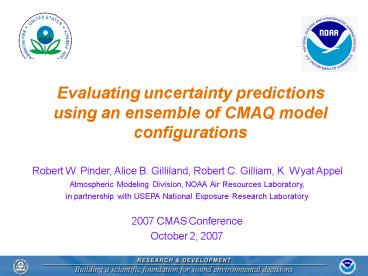PUT TITLE HERE - PowerPoint PPT Presentation
1 / 19
Title:
PUT TITLE HERE
Description:
Robert W. Pinder, Alice B. Gilliland, Robert C. Gilliam, K. Wyat Appel. Atmospheric Modeling Division, NOAA Air Resources Laboratory, ... – PowerPoint PPT presentation
Number of Views:49
Avg rating:3.0/5.0
Title: PUT TITLE HERE
1
Evaluating uncertainty predictions using an
ensemble of CMAQ model configurations
Robert W. Pinder, Alice B. Gilliland, Robert C.
Gilliam, K. Wyat Appel Atmospheric Modeling
Division, NOAA Air Resources Laboratory, in
partnership with USEPA National Exposure Research
Laboratory 2007 CMAS Conference October 2, 2007
2
Objective
- Uncertainty what is the likelihood that the
observed value is within a given range? - Applications
- Exposure studies
- Diagnostic evaluation tool
- One measure of uncertainty is the error when the
model is compared with observations. - Can we use an ensemble approach to make a better
estimate of this range?
Histogram of CMAQ O3 Model Error 8-hour max O3,
228 AQS Sites from the SE US
3
Sources of Uncertainty
Structural Uncertainty VOC species
lumping Physical processes Approach vary
representation Parameter Uncertainty Emissions
Meteorology Chemical rate constants Approach
Monte Carlo methods
Challenge Monte Carlo methods are not feasible
given CMAQs computational requirements.
4
Method
- Variety of CMAQ / MM5 model configurations
- Direct sensitivity calculations
- Use observations to remove spurious ensemble
members
5
Generate Ensemble Members for Structural
Uncertainty using Multiple Model Configurations
- Planetary Boundary Layer / Land Surface Model
- Pleim-Xiu Land Surface Model ACM Asymmetric
Convective Model (Pleim and Chang, 1992) - Miller-Yamada-Janjic (Janjic, 1994), NOAH Land
Surface Model - Medium Range Forecast (Hong and Pan, 1996), NOAH
Land Surface Model - Chemical Mechanism
- Carbon Bond IV
- SAPRC-99
- Six structural uncertainty cases
6
Generate Ensemble Members for Parametric
Uncertainty using Direct Sensitivity Calculation
- Use the Direct Decoupled Method (DDM) to
calculate sensitivity to - NOx Emissions
- VOC Emissions
- Second-order sensitivity
- O3 Boundary conditions
At each grid cell, calculate ozone response to
emissions and boundary concentrations
Compared to brute-force calculation, errors are
5-10 (Cohan et al., 2005)
7
Direct Calculation of Ozone SensitivityJuly 16,
2002, 2 PM
O3 (ppb)
gt30
-5
0
5
10
15
20
25
8
Use Observations to Constrain Ensemble
AQS O3 Monitoring Sites
Used to evaluate boundary conditions
Used to evaluate ensemble quality
9
Structural uncertainty simulations (6)
Use DDM to calculate O3 sensitivity to NOx, VOC,
and boundary conditions.
Randomly sample from range of uncertain NOx
emissions, VOC emissions, boundary
concentrations, and structural uncertainty cases
Use observations to remove spurious ensemble
members
Repeat 200 times
Generate an ensemble member by calculating the O3
field across SE US domain
10
Example Atlanta, GeorgiaJuly 1-28, 2002
11
Structural Uncertainty
12
Structural Parametric Uncertainty
Spread is large can we use the observations to
narrow this range?
13
Prune ensemble members not consistent with
observations
Remove ensemble members that do not constrain the
range
14
Pruned ensemble has narrow range while still
including observations
200 member ensemble 10 member ensemble
15
Compare with /-30
30 of base case CMAQ 10 member ensemble
Range is 40 lower
16
Analysis at all sites
- Dataset
- 38 locations, 28 days
- 1064 observations
- Evaluation
- Randomly reserve 50 of dataset
- Derive ensemble, prune using half of observations
- Evaluate using the reserve dataset
- Ensemble range includes 85 of observations
- Range is 40 smaller than 30 of base case
AQS O3 Monitoring Sites
17
Trade-off between coverage of observations and
spread in range
18
Conclusions
- This ensemble generation and pruning technique
provides a more robust uncertainty range - Observed value is within the range 85 of the
time - 40 reduction in spread compared to /- 30 rule
- Simultaneously narrowing these bounds and
improving the performance depends on reducing
structural errors in CMAQ - Locations and times that fall outside of the
ensemble range should be targeted for uncovering
structural errors in the model
19
AcknowledgementsSergey Napelenok, Jenise
Swall, Kristen Foley
DISCLAIMER The research presented here was
performed under the Memorandum of Understanding
between the U.S. Environmental Protection Agency
(EPA) and the U.S. Department of Commerce's
National Oceanic and Atmospheric Administration
(NOAA) and under agreement number DW13921548.
This work constitutes a contribution to the NOAA
Air Quality Program. Although it has been
reviewed by EPA and NOAA and approved for
publication, it does not necessarily reflect
their policies or views.































